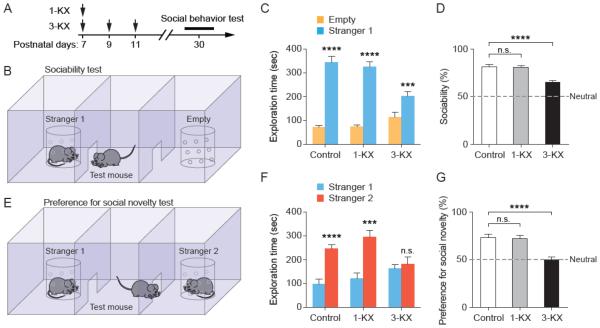Fig. 2.
Multiple, but not single, exposures to KX anesthesia at neonatal age result in impaired social behavior in adulthood. (A) Timeline for neonatal anesthetic exposure and social behavior tests in young adulthood. (B) Diagram of three-chambered sociability test. (C) The amount of time that the test mice spent exploring empty chamber and an unfamiliar mouse. Control: t(9) = 8.811, P < 0.0001; 1-KX: t(9) = 12.34, P < 0.0001; 3-KX: t(9) = 5.545, P = 0.0004, paired t test. n = 10 mice for each group. (D) Sociability was expressed the percentage of time that the test mouse spent in the side with an unfamiliar mouse (stranger 1) relative to the total time spent in both sides. Sociability was significantly reduced in 3-KX, but not 1-KX group, as compared to control. F(2, 27) = 20.07, P < 0.0001 by one-way ANOVA. P = 0.99 for 1-KX vs. control, P < 0.0001 for 3-KX vs. control, Tukey’s post hoc test. (E) Preference for social novelty test was conducted immediately after sociability test. (F) The amount of time that the test mouse spent exploring each stranger. Control: t(9) = 8.899, P < 0.0001; 1-KX: t(9) = 5.279, P = 0.0005; 3-KX: t(9) = 0.7485, P = 0.4733, paired t test. n = 10 mice for each group. (G) Social preference was expressed the percentage of time that the test mouse spent with the unfamiliar mouse (stranger 2) relative to the total time spent with both sides. Social preference was significantly reduced in 3-KX, but not 1-KX group, as compared to control. F(2, 27) =15.95, P < 0.0001 by one-way ANOVA. P = 0.9646 for 1-KX vs. control, P < 0.0001 for 3-KX vs. control, Tukey’s post hoc test. Data are presented as means ± SEM. ***P < 0.001, ****P < 0.0001, n.s., not significant.

